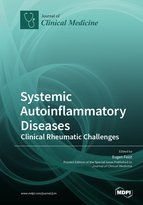Systemic Autoinflammatory Diseases—Clinical Rheumatic Challenges
A special issue of Journal of Clinical Medicine (ISSN 2077-0383). This special issue belongs to the section "Immunology".
Deadline for manuscript submissions: closed (1 August 2021) | Viewed by 76932
Special Issue Editor
Interests: autoinflammation; adult onset Still’s disease; biomarkers; inflammasome; proteasome;rheumatology; rheumatoid arthritis; biologic drugs
Special Issues, Collections and Topics in MDPI journals
Special Issue Information
Dear Colleagues,
Autoinflammation, as a relatively new field in clinical rheumatology, has gained an increasing importance in recent years. The number of identified entities and affected patients has gradually increased, and some of the involved pathways have already been identified. This progress allows a deeper understanding of closely linked diseases, namely, inflammasomopathies, interferonopathies, Relo-pathies, and proteasome associated syndromes. These insights have not only improved their classification but also helped to identify new treatment targets of pro-inflammatory cytokines, including IL-1ß, IL-6, interferon-, and TNF-alpha. Nevertheless, there is still a high medical need, especially in reliable outcome measures, for confirmation of data from controlled clinical trials and, finally, also for long-term experience from registers.
The Special Issue entitled “Systemic Autoinflammatory Diseases—Clinical Rheumatic Challenges” of the Journal of Clinical Medicine is now open for submissions. This issue welcomes all types of papers on the broad spectrum of clinical characteristics, prognosis, pathophysiology, and treatment of autoinflammatory diseases. The goal of this Special Issue is to further raise awareness of autoinflammatory processes and to better separate them from well-established autoimmune diseases. It is clear that we have entered a new age in this complex field, linking rheumatology even closer to immunology.
Prof. Dr. Eugen Feist
Guest Editor
Manuscript Submission Information
Manuscripts should be submitted online at www.mdpi.com by registering and logging in to this website. Once you are registered, click here to go to the submission form. Manuscripts can be submitted until the deadline. All submissions that pass pre-check are peer-reviewed. Accepted papers will be published continuously in the journal (as soon as accepted) and will be listed together on the special issue website. Research articles, review articles as well as short communications are invited. For planned papers, a title and short abstract (about 100 words) can be sent to the Editorial Office for announcement on this website.
Submitted manuscripts should not have been published previously, nor be under consideration for publication elsewhere (except conference proceedings papers). All manuscripts are thoroughly refereed through a single-blind peer-review process. A guide for authors and other relevant information for submission of manuscripts is available on the Instructions for Authors page. Journal of Clinical Medicine is an international peer-reviewed open access semimonthly journal published by MDPI.
Please visit the Instructions for Authors page before submitting a manuscript. The Article Processing Charge (APC) for publication in this open access journal is 2600 CHF (Swiss Francs). Submitted papers should be well formatted and use good English. Authors may use MDPI's English editing service prior to publication or during author revisions.
Keywords
- autoinflammation
- inflammasomopathies
- interferonopathies
- Relo-pathies
- proteasome associated syndromes
- pro-inflammatory cytokines
- biomarkers
- inflammasome







